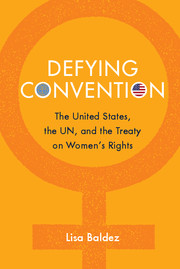Book contents
- Frontmatter
- Dedication
- Contents
- Acknowledgments
- 1 Introduction
- 2 A Scaffolding for Global Women’s Rights, 1945–1970
- 3 Geopolitics and Drafting the UN Treaty on Women’s Rights
- 4 An Evolving Global Norm of Women’s Rights
- 5 CEDAW Impact: Process, Not Policy
- 6 Why the United States Has Not Ratified CEDAW
- 7 CEDAW and Domestic Violence Law in the United States
- 8 Conclusion
- Works Cited
- Index
2 - A Scaffolding for Global Women’s Rights, 1945–1970
Published online by Cambridge University Press: 05 August 2014
- Frontmatter
- Dedication
- Contents
- Acknowledgments
- 1 Introduction
- 2 A Scaffolding for Global Women’s Rights, 1945–1970
- 3 Geopolitics and Drafting the UN Treaty on Women’s Rights
- 4 An Evolving Global Norm of Women’s Rights
- 5 CEDAW Impact: Process, Not Policy
- 6 Why the United States Has Not Ratified CEDAW
- 7 CEDAW and Domestic Violence Law in the United States
- 8 Conclusion
- Works Cited
- Index
Summary
The first sentence of the Charter of the United Nations, written in 1945, vows to put an end to war. The second sentence establishes gender equality. As the Charter reads:
We the peoples of the United Nations determined
• To save succeeding generations from the scourge of war, which twice in our lifetime has brought untold sorrow to mankind, and
• To reaffirm faith in fundamental human rights, in the dignity and worth of the human person, in the equal rights of men and women and of nations large and small. (United Nations 1945 )
(United Nations 1945)It is extraordinary to read an explicit affirmation of gender equality, so prominently placed, in a document of profound global importance, drafted at a moment in time not generally associated with strong support for feminism. The statement stands out for suggesting that “the equal rights of men and women” is a “fundamental human right,” an idea whose meaning took the world many decades to acknowledge fully. The clear guarantee of gender equality promised in the UN Charter provided an unprecedented opportunity for the women of the world to claim a new status as equals in the postwar era. It set the United Nations on a path toward becoming an institution of primary importance to advancing the status of women into the future. Nonetheless, many decades passed before the commitment implied in the UN Charter became a global norm.
During the UN’s first twenty-five years, advocates of gender equality accomplished many things. The explicit inclusion of gender equality in the UN Charter counts as their first success. The UN then created the CSW as an independent entity within the Economic and Social Council in 1946. In the 1950s and 1960s, the CSW got the UN General Assembly to approve a series of international treaties on specific areas of women’s rights: the Convention on the Political Rights of Women (1952); Convention on the Nationality of Married Women (1957); and Convention on Consent to Marriage, Minimum Age for Marriage and Registration of Marriages (1962). In 1967, the General Assembly adopted the Declaration on the Elimination of Discrimination against Women, a comprehensive statement affirming the political, civil, social, and economic rights of women.
- Type
- Chapter
- Information
- Defying ConventionUS Resistance to the UN Treaty on Women's Rights, pp. 32 - 62Publisher: Cambridge University PressPrint publication year: 2014



